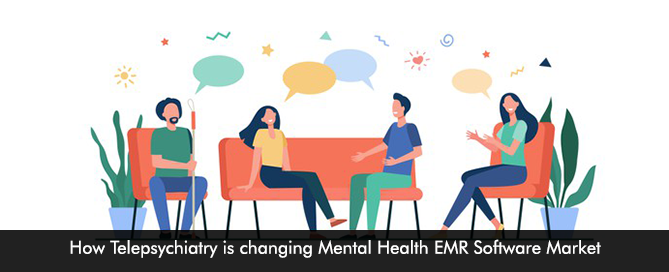It’s mental health awareness week 2021, and we are fortunate to talk about something positive amidst the COVID-19 pandemic. Throughout the past year, many people are experiencing mental health disorders such as anxiety and depression due to isolation and a sudden change in social dynamics because of the virus.
In the past year, Telemedicine EMR Software system adaptation rates have increased in hospitals and clinics in the US to provide healthcare services to patients remotely. In this article, we will talk about Telepsychiatry which is a branch of telemedicine.
What is Telepsychiatry?
Telepsychiatry uses telecommunication to connect mental health providers with patients from the comfort of their homes. Psychiatrists can directly communicate with their patients via video conferencing to help them cope with various mental health disorders.
The following mental health services can be offered through telepsychiatry according to American Psychiatric Association (APA),
- Psychiatric assessment and diagnosis
- Individual therapy
- Group therapy
- Family therapy
- Medication management
How effective is telepsychiatry?
Telepsychiatry is seen as effective to provide mental health treatment and diagnosis to patients who don’t feel comfortable visiting the therapist’s office amidst the pandemic and the stigma attached to receiving therapy.
APA suggests that telepsychiatry has improved patient outcome levels and leads to better patient engagement and satisfaction scores. The association also reveals that getting treatment via telepsychiatry is the same as getting in-person treatment and has a positive impact on quality of care and does not hamper patient privacy.
Research suggests that telepsychiatry is an effective platform to treat various mental health disorders such as post-traumatic stress disorder, anxiety, and substance abuse.
What are the benefits of telepsychiatry?
Telepsychiatry meets patient needs by providing convenience and quick treatment options. The platform benefits patients in the following ways;
- Improves access to mental health providers and extends reach to rural areas.
- Care opportunity from the patient’s home.
- The patient doesn’t need to travel down to the doctor’s office for therapy.
- Prompt care reduces delay in treatment.
- Improves care coordination and helps to reduce patient relapse due to better follow-up.
- Enhances patient outcomes.
- The patient can receive treatment privately without having to deal with the stigma associated with receiving mental health treatment.
- A 2016 report suggests the method is cost-effective
Through the robust platform, the psychiatrist can prescribe the right medications and decide on the best treatment path for the patient. The therapist can also refer the patient to other services uses telepsychiatry. In the US telepsychiatry is available in many mental health centers, schools, nursing homes, and primary care centers to provide timely treatment options for patients dealing with depression, anxiety, sleep disorders, and substance abuse.
Key takeaway
Telepsychiatry has provided a window of opportunity for patients to receive effective diagnosis and treatment of mental illness from their homes. Mental health should be everyone’s priority as happy and stable individuals can better contribute to society. By offering instant and vital support through telepsychiatry patients can overcome mental health issues and thrive both at work and home.







